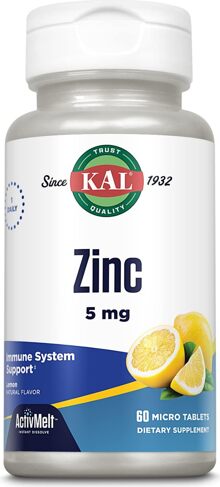
KAL Zinc
Go to Store| Serving Size: 1 Tablet | ||
| Servings Per Container: | ||
| Amount Per Serving | % DV * | |
| Zinc (from Zinc Oxide) | 5mg | 45% |
|
* % Daily Value (DV) is based on a 2,000 calorie diet. Your daily values may be higher or lower based on your calorie needs.
† Daily Value (DV) not established. |
||
|
Other Ingredients: Mannitol starch complex (from non-gmo corn), cellulose, natural lemon flavor with other natural flavors, polysaccharides (from non-gmo soy), mono & diglycerides, sorbitol, citric acid, sodium bicarbonate, magnesium stearate, malic acid, stevia (leaf extract) and silica. |
||
|
Directions: Dissolve one ActivMelt™ micro tablet on the tongue daily. Use only as directed. |
||
|
Warnings: Do not use if safety seal is broken or missing. Keep out of reach of children. Keep your licensed health care practitioner informed when using this product. Store in a cool, dry place. |
||
| Serving Size: 1 Tablet | ||
| Servings Per Container: 60 | ||
| Amount Per Serving | % DV * | |
| ZINC - (FROM ZINC OXIDE) | 5mg | 33% |
|
* % Daily Value (DV) is based on a 2,000 calorie diet. Your daily values may be higher or lower based on your calorie needs.
† Daily Value (DV) not established. |
||
|
Other Ingredients: Mannitol Starch Complex (non-GMO corn), Cellulose, Polysaccharides (non-GMO soy), Natural Lemon Flavor with Other Natural Flavors (non-GMO soy), Sorbitol, Mono & Diglycerides, Citric Acid, Sodium Bicarbonate, Magnesium Stearate, Malic Acid, Stevia and Silica. |
||
|
Directions: Use only as directed. Dissolve one ActivMelt™ micro tablet onthe tongue daily. |
||
|
Warnings: Do not use if safety seal is broken or missing. Keep out ofreach of children. Keep your licensed health care practitioner informed when using this product. |
||

KAL Zinc
Go to StoreKAL Zinc 5mg 60 Micro Tablets
KAL Micro Tablets are tasty naturally lemon flavored Micro Tablets that quickly dissolve in the mouth for maximum absorption. Zinc is used to strengthen the immune system, speed up wound healing, and support thyroid function among a host of other benefits.
KAL Zinc 5mg 60 Micro Tablets Highlights & Benefits
- Supports Immune Function
- Speeds Up Wound Healing
- Supports Thyroid Function
- Tasty Natural Lemon Flavored Lozenges
- Featuring ActivMelt Technology
- Vegetarian Friendly
Directions
Take 1 tablet per day under the tongue.
KAL Zinc 5mg 60 Micro Tablets Ingredients & Supplement Facts
Warnings & Side Effects
Store in a cool dry place after opening.
References
Kołodziejczak-Radzimska A, Jesionowski T. Zinc Oxide-From Synthesis to Application: A Review. Materials (Basel). 2014 Apr 9;7(4):2833-2881. doi: 10.3390/ma7042833. PMID: 28788596; PMCID: PMC5453364.
https://www.ncbi.nlm.nih.gov/pmc/articles/PMC5453364/
Keerthana S, Kumar A. Potential risks and benefits of zinc oxide nanoparticles: a systematic review. Crit Rev Toxicol. 2020 Jan;50(1):47-71. doi: 10.1080/10408444.2020.1726282. Epub 2020 Mar 18. PMID: 32186437.
https://pubmed.ncbi.nlm.nih.gov/32186437/
†We make every effort to ensure that the product images displayed on our website faithfully represent what you will receive. However, we recognize that digital representations can sometimes fall short of capturing every nuance of the product's physical attributes. Differences in color, size, and packaging details might exist. To mitigate this, we advise our valued customers to delve into the product descriptions where the specific features, ingredients, and usage instructions of each product are meticulously outlined. This approach helps bridge the gap between expectation and reality, ensuring you are fully informed about your purchase.
†These statements have not been evaluated by the Food and Drug Administration. This product is not intended to treat, cure, diagnose, or prevent any disease.
†California Proposition 65 Notice: Some of our products may carry a California Proposition 65 warning because they contain trace amounts of chemicals listed by the State of California as known to cause cancer, birth defects or other reproductive harm. This law is a “right-to-know” requirement and does not necessarily mean the product is unsafe or in violation of any safety standard. We rely on the product manufacturer’s instruction for these warnings; as a retailer we do not perform individual safety testing. If you have questions, please contact the manufacturer directly or consult a qualified healthcare professional.





